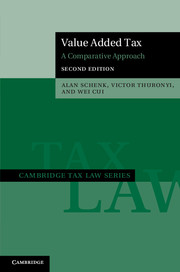Book contents
- Frontmatter
- Dedication
- Contents
- List of Tables and Charts
- List of Cases
- Preface to the Second Edition
- 1 Introduction
- 2 Consumption Tax Forms and Base Alterations
- 3 Varieties of VAT in Use
- 4 Registration, Taxpayer, and Taxable Activity
- 5 Taxable Supplies and Tax Invoices
- 6 The Tax Credit Mechanism
- 7 Introduction to Cross-Border Aspects of VAT
- 8 Timing and Valuation Rules
- 9 Zero-Rating, Exemptions, and Exempt Entities
- 10 VAT Evasion and Avoidance
- 11 Gambling and Financial Services (Other than Insurance)
- 12 Insurance
- 13 Real Property
- 14 An Anatomy of the Chinese VAT
- 15 Interjurisdictional Aspects
- Appendix VATs Worldwide
- Index
- References
15 - Interjurisdictional Aspects
Published online by Cambridge University Press: 05 February 2015
- Frontmatter
- Dedication
- Contents
- List of Tables and Charts
- List of Cases
- Preface to the Second Edition
- 1 Introduction
- 2 Consumption Tax Forms and Base Alterations
- 3 Varieties of VAT in Use
- 4 Registration, Taxpayer, and Taxable Activity
- 5 Taxable Supplies and Tax Invoices
- 6 The Tax Credit Mechanism
- 7 Introduction to Cross-Border Aspects of VAT
- 8 Timing and Valuation Rules
- 9 Zero-Rating, Exemptions, and Exempt Entities
- 10 VAT Evasion and Avoidance
- 11 Gambling and Financial Services (Other than Insurance)
- 12 Insurance
- 13 Real Property
- 14 An Anatomy of the Chinese VAT
- 15 Interjurisdictional Aspects
- Appendix VATs Worldwide
- Index
- References
Summary
Introduction
Almost all national-level (central-government) VATs rely on the destination principle to tax international transactions, with tax imposed on imports and removed from exports. The adoption at the subnational level of some form of VAT (see Table 2.7 for a review of the forms) is being debated or enacted in many countries. There has been renewed interest in the problems of cross-border trade in the EU and within federal systems, especially in Canada, India, Brazil, and the United States. In addition to the long-standing problems faced by the EU and federal countries with cross-border trade, some of the recent attention to these issues has been propelled by the explosion of trade over the Internet (electronic or e-commerce). Indeed, the US Congress enacted a moratorium on subnational (state level) taxes on Internet access and on multiple or discriminatory taxes on e-commerce.
Subnational units of government should control the revenue necessary to provide the services that they render. In any federal system, the fiscal authority and responsibility of subnational (referred to in this chapter also as regional) units of government must be established. To possess ultimate fiscal autonomy, subnational units of government should have the authority to choose the taxes to be levied, define their tax bases, set their tax rates, and administer the taxes they impose, but these elements can also be shared with national government.
- Type
- Chapter
- Information
- Value Added TaxA Comparative Approach, pp. 487 - 530Publisher: Cambridge University PressPrint publication year: 2015



